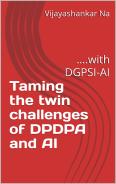This is our response to the Government seeking public comments on Bitcoin regulation:
Query 1: Whether Virtual Currencies (VCs) should be banned, regulated or observed?
Response:
Firstly we would like to say that “Banning” is also “Regulation”. Hence when we say VC should be regulated, it includes the option of “Banning”.
Secondly, by “Virtual Currency” we are speaking of Crypto Currencies and not the money kept in digital form in Mobile wallets, Internet Banking accounts, virtual prepaid cards etc.
Thirdly, “Observing” is meaningless. Government of India has been observing the development of Bitcoin from being a technology wonder to a currency of the criminals. Just as our “Procrastination Policy of Kashmir” has today brought Kashmir to the brink of disaster, while RBI kept on observing the Bitcoin, the epidemic spread far and wide. Most black currency holders have found it more convenient to transfer their Swiss Bank balances to Bitcoins before the Government could make up its mind. Now the seasoned criminals have started moving out of Bitcoins and acquiring other Crypto currencies and hence it has become necessary to regulate/ban all Crypto currencies to ensure that the adverse impact of Bitcoin on the society is mitigated.
Three years back, we suggested that RBI should start its own version of a Bitcoin. It did not listen. At the same time while countries like China started accumulating Bitcoin wealth, our economists did not understand the impact of lopsided holding of Bitcoins when this decision of whether to legitimize Bitcoin or not came up. They kept observing and observing and I donot know what the Government means that it is also an option to consider.
After seeing that the recent ransom-ware attacks thrived on Bitcoins, there is a distinct possibility of ISI using Bitcoins as an easy option to distribute money in India instead of throwing fake currency bundles across the border in Malda is a definite possibility. We can safely make a guess that all stone pelters in Kashmir will in future get payments in terms of Centi BTCs or Milli BTCs (1 BTC=Rs 150,000/. 1 Centi BTC =Rs 1500/-. 1 Milli BTC =Rs 150/-).
In our opinion therefore, Bitcoin at present does not deserve the respect of a technology wonder. It is squarely the currency of the criminals and terrorists and it should be part of the National Security strategy to regulate Bitcoins in such a manner that it is not used to finance the terrorists and criminals in any manner.
If Bitcoin needs to be legalized today, it would also mean that we legitimize the current stock of Bitcoins all over the world estimated at around 16 million as against the theoretical maximum possibility of 21 million. It would also mean that all the current holdings with criminals, drug mafia, terrorists etc will get a recognized avenue to dump them in India.
The economic impact of allowing a Crypto Currency to take over the recognized Indian currency is definitely going to be adverse.
Many of the bureaucrats may in fact try to support Bitcoins because either they may already have parked their current Black money in the form of these Crypto Currencies or looking at the possibility of using it in future.
Modi Government which is trying to tackle the Black Money menace in India should not fall into this trap of looking at Bitcoins as an acceptable risk just because Canada or Japan has legalized it. In fact we should not only oppose Bitcoin use in India but also bring pressure on other countries not to legitimize Bitcoin or other private Crypto Currencies.
The net opinion is clear. We should not allow Bitcoin or other Private Crytpto Currencies to be legitimized in India.
On the other hand, if RBI wants to start its own Crypto Currency such as “Bit Rupee”, then it is welcome. This will be a fully regulated Crypto Currency where every unit is tagged with an RBI code. This stock of Bit Rupees will be a replacement of the current paper currency where instead of printing of the Paper currency, RBI may either itself mint the Bit Rupee or license Bit rupee mining through a secure non tamperable hardware control chip that has to be used by all licensed miners. The exact rules and regulations of such a “Bit Rupee Mining License” may be discussed at the appropriate time as a part of the regulation of such a system.
As a part of current regulation, Bitcoin and all other private Crypto Currencies have to be declared as illegitimate and its holdings should be considered as illegal. All present owners of these coins should surrender them to the Government with a proof of the acquisition through known sources of income as a “One time amnesty scheme”.
Part of the support that the Bitcoin legitimization is now receiving is from those who already have some holding and fear a financial loss if Bitcoins are banned. There is also one part of the community which is supporting Bitcoin because they think it is similar to other digital money and hence part of the digital progress which we want to achieve. By declaring the amnesty scheme and properly explaining the adverse impact of a currency that finances terrorists and operates outside the economy, most members of the public will support immediate de-recognition of Bitcoins and other private Crypto currencies. They will all and support the Bit Rupee creation as an alternative use of the Block Chain technology which is definitely innovative and useful.
Query 2. What measures to be taken to protect Consumer Protection?
Response:
If Private Crypto currencies are allowed, then it may work like a Ponzi scheme where the early birds will get the benefits and late entrants will lose.
Secondly, Bitcoin holdings are held in “Bitcoin Wallets” which are services provided by private organizations many of them with unknown reputation. If these Wallet companies close shop, all the holdings become unrecoverable. Since the essence of Bitcoins is the secrecy and confidentiality, there will be no evidence based on which the consumer can seek legal protection against either the fraudulent practices of wallet companies or exchanges or the security breaches that may arise in such companies because of their vulnerabilities, real or faked.
There is therefore no way Consumer Protection can be enabled for Bitcon/Crypto currency transactions.
The only precaution that the Government may be able to take is to say that the KYC of wallet owners have to be verified. But this will be abused royally since it goes against the basic tenets of any Crypto Coin system.
If RBI introduces its own Crypto currency, there may be a possibility of the digital signature of a person issued by an Indian Licensed Certifying Authority is embedded into every transaction. But this may not be practically possible.
Query 3.What measures should be taken to promote orderly development of VCs.
Response:
All Crypto currencies which are managed by private algorithms must be banned. Only Crypto currencies issued by RBI should be permitted. If any foreign Government wants to start a similar Government controlled Crypto Currency, it can be given recognition similar to the current foreign exchange system as part of FEMA provided conversion of private crypto currencies into such Government controlled Crypto currencies is not freely permitted. The total value of Crypto currencies issued by a country should be considered as part of the “Notes Issued” so that indiscriminate printing of crypto currencies should be avoided.
Query 4. Which appropriate institution(s) should monitor/ regulate the VCs?
RBI should be the institution to regulate the Crypto currencies. If required they can create a subsidiary to manage the techno-legal- financial implications with a representation of appropriate experts from the public.
In the past RBI working groups have been constituted with vested interests from industry being part of the group for manipulating the decisions from within.
This should be strictly avoided.
Query 5: In case VCs are not suggested to be regulated:
i). What should be the effective self-regulatory mechanism?
ii). What measures should be adopted to ensure consumer protection in this scenario?
Response:
It is our firm opinion that “Not Regulating Crypto Currencies” is not an option. There is no “Self Regulatory” mechanism that can bring in privately created “Money” to be brought into the system. If private minting of digital currency is printed, Government will not have any legal logic to prevent private printing of paper currency. Every group of people like say residents of a 1000 apartment housing complex may say that they will print their own Coupons which will be currencies within their complex. Gradually there will be myriad versions of closed group paper currencies that will compete with the legal currency and Government will not be able to say that there will be one rule for digital money and another for paper money.
Non Regulation would be a fraud on Indian society and if Government even thinks about it, the decision would be challenged in the Court and Mr Modi’s image will be tarnished.
Summary:
-Ban all Private Crypto Currency
-Provide a one time amnesty scheme for conversion of current holdings but only if the acquisition is with accounted money.
-Introduce an RBI controlled Crypto currency with an RBI tag and owner identity tag embedded into every transaction unit.
-Create a subsidiary of RBI for managing the regulation with proper representation of independent and reliable experts
(Further Comments from readers are welcome)
Naavi









